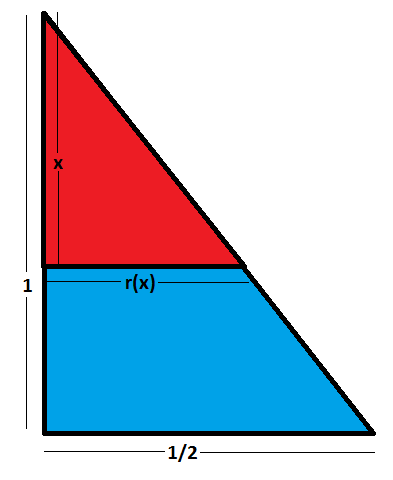Science:Math Exam Resources/Courses/MATH101/April 2010/Question 04/Solution 1
Consider the diagram for building the anthill

. We can think of building the hill as stacking several small cylinders of height or (thinking forward to integration) from the ground (x=1) to the top (x=0). Consider the anthill at some intermediate distance from the top x (at a distance 1-x from the ground). This point is represented in the diagram as . The volume of a new cylinder to add onto the anthill will be
where dx is the height of the cylinder and r(x) is the radius of the anthill at the current height. There is a similar triangle problem between the top of the completed anthill and the current disk we're looking at

and so we can determine the radius at our current height x via
and so
Notice that indeed when we're at the top (x=0) then the radius is zero and when we're at the bottom (x=1) that the radius is 1/2. We therefore have that the new amount of sand volume we are adding is
In the problem we are given a density which is actually a force density because lbs is a measure of force (note that this means, unlike for a mass density, we do not need to multiply by acceleration). This is telling us the force required to lift sand of a given volume which is precisely what we are trying to do with our cylinder of sand and so the force required to lift it is
force = force density volume
The work required to lift this cylinder to its position in the hill at x will be this force dF multiplied with the height we have to lift it from the ground 1-x. Therefore the amount of work to lift this cylinder is
This is the work to build one small cylinder. The whole hill is built by adding cylinders for all values of x and so to get the total work we integrate
Let us do a quick sanity check on the units to see if we have missed out anything.
The volume is in , and the density is given in , so the weight is in , finally work is force (weight) times distance (which is in ), so we get our work to be in , which is right.
In conclusion, the work done by the ants to build the anthill is .











![{\displaystyle {\begin{aligned}{\text{work}}=\int _{0}^{1}{\textrm {d}}W&=\int _{0}^{1}{\frac {150\pi }{4}}x^{2}\,(1-x)dx\\&=\left[{\frac {150\pi x^{3}}{12}}-{\frac {150\pi x^{4}}{16}}\right]_{0}^{1}\\&={\frac {150\pi }{12}}-{\frac {150\pi }{16}}\\&={\frac {25\pi }{8}}\end{aligned}}}](https://wiki.ubc.ca/api/rest_v1/media/math/render/svg/a073186632623087bf5b3c20b8f41f0211a722fb)





